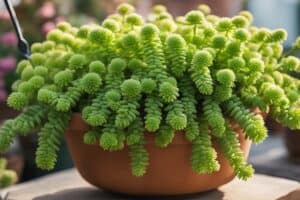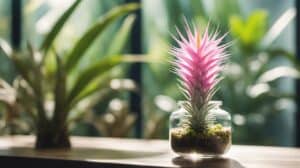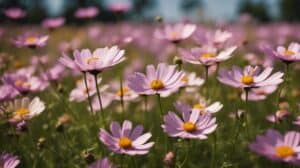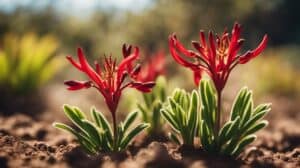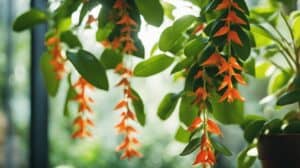The Goldfish Plant (Nematanthus gregarius) is a charming and unique tropical plant that is coveted by many plant enthusiasts. Its vibrant orange and yellow flowers resemble the scales of a goldfish, hence its name. While it can be found in many nurseries and garden centers, propagating the Goldfish Plant can be a challenge. In this article, we will share some secrets to successfully propagating this aquatic charm.

One of the reasons why propagating the Goldfish Plant can be difficult is because it requires specific conditions to thrive. It prefers bright, indirect light and well-draining soil. Additionally, it needs to be kept consistently moist but not waterlogged. These factors can make it tricky to get cuttings to take root and grow into healthy plants. However, with the right techniques, it is possible to propagate the Goldfish Plant and create a beautiful collection of these unique plants.
In this article, readers will learn the step-by-step process of propagating the Goldfish Plant, including the best time of year to take cuttings, how to prepare the cuttings for rooting, and how to care for the new plants as they grow. Whether you are a seasoned plant propagator or a beginner, these tips and tricks will help you successfully grow your own Goldfish Plants.
Understanding Goldfish Plant Basics
Species Overview
The Goldfish Plant (Nematanthus gregarius) is a tropical plant native to Central and South America. It is a member of the Gesneriaceae family, which includes other popular houseplants like African Violets and Gloxinias. The Goldfish Plant is so named because its bright orange flowers resemble goldfish swimming in a bowl. The plant has glossy green leaves that are slightly serrated and grow to about 2 inches long.
Goldfish Plants are compact and bushy, growing up to 12 inches tall and 24 inches wide. They are often grown as houseplants and are prized for their unique flowers and attractive foliage. There are several cultivars of Goldfish Plants available, each with its own unique flower color and shape.
Ideal Growing Conditions
Goldfish Plants are relatively easy to care for and can thrive in a variety of indoor environments. Here are some ideal growing conditions for Goldfish Plants:
-
Light: Goldfish Plants prefer bright, indirect light. They can tolerate some direct sunlight, but too much can scorch their leaves. Place your Goldfish Plant near a window that receives morning or afternoon sun, but avoid direct midday sun.
-
Temperature: Goldfish Plants prefer warm temperatures between 60-75°F. They can tolerate slightly cooler temperatures, but avoid exposing them to temperatures below 50°F.
-
Humidity: Goldfish Plants prefer high humidity levels. You can increase humidity by placing a tray of water near your plant or by using a humidifier.
-
Watering: Goldfish Plants prefer consistently moist soil. Water your plant when the top inch of soil feels dry to the touch. Avoid overwatering, as this can lead to root rot.
-
Soil: Goldfish Plants prefer well-draining soil that is rich in organic matter. Use a potting mix that contains peat moss, perlite, and vermiculite.
By providing your Goldfish Plant with the proper growing conditions, you can encourage healthy growth and beautiful blooms.
Propagating Goldfish Plants

Goldfish plants are beautiful and unique plants that can easily be propagated through stem or leaf cuttings. Here are two methods to propagate goldfish plants.
Stem Cutting Method
To propagate goldfish plants using stem cuttings, follow these steps:
- Choose a healthy stem with at least two sets of leaves.
- Cut the stem at a 45-degree angle just below a node.
- Remove the lower leaves, leaving only the top two sets of leaves.
- Dip the cut end of the stem in rooting hormone.
- Plant the stem in moist soil or a rooting medium.
- Keep the soil moist and place the cutting in a bright, indirect light.
- After a few weeks, the stem should start to grow roots and new leaves.
Leaf Cutting Technique
To propagate goldfish plants using leaf cuttings, follow these steps:
- Choose a healthy leaf with a stem attached.
- Cut the stem at a 45-degree angle just below the leaf.
- Dip the cut end of the stem in rooting hormone.
- Plant the stem in moist soil or a rooting medium.
- Cover the cutting with a plastic bag to create a humid environment.
- Keep the soil moist and place the cutting in a bright, indirect light.
- After a few weeks, the stem should start to grow roots and new leaves.
Propagation of goldfish plants can be a fun and rewarding experience for any plant lover. With these simple techniques, anyone can easily propagate goldfish plants and enjoy their beauty in multiple locations.
Caring for New Propagations

When it comes to caring for new propagations of Nematanthus gregarius, there are a few things to keep in mind to ensure their success. Here are some tips to help you get started:
Soil and Potting
It is essential to use a well-draining soil mix when potting new propagations. A mix of peat moss, perlite, and vermiculite is ideal. Make sure the pot has drainage holes to prevent water from accumulating at the bottom. It is also important to choose a pot that is slightly larger than the root ball to allow room for growth.
Watering and Feeding
New propagations require frequent watering to keep the soil moist but not waterlogged. It is recommended to water them once a week or when the top inch of soil feels dry to the touch. Do not allow the soil to completely dry out between waterings. When it comes to feeding, use a balanced liquid fertilizer once a month during the growing season.
Light and Temperature
Nematanthus gregarius prefers bright, indirect light. Direct sunlight can scorch the leaves, so it is best to place the plant near a window that receives filtered light. The ideal temperature range for this plant is between 60-75°F (15-24°C). Avoid placing it near drafty windows or doors as this can cause stress to the plant.
By following these simple tips, you can ensure the successful growth and development of your new Nematanthus gregarius propagations.
Frequently Asked Questions

How can I propagate my Goldfish Plant using water?
One of the easiest ways to propagate a Goldfish Plant is by using water. Simply cut off a healthy stem with a few leaves and submerge it in a jar of water. Change the water every few days to prevent bacteria growth and wait for roots to form. Once roots have grown to about an inch in length, transfer the stem to a pot with well-draining soil.
What are the ideal conditions for Goldfish Plant propagation?
Goldfish Plants thrive in warm and humid environments. To propagate successfully, keep the plant in a location with indirect sunlight and temperatures between 65-80°F. Use a well-draining soil mix and keep the soil moist but not waterlogged.
What are some effective care tips for a thriving Goldfish Plant?
Goldfish Plants require consistent care to thrive. Keep the soil moist but not waterlogged, and fertilize every two weeks during the growing season. Prune regularly to encourage bushy growth and pinch off spent blooms to promote more flowers.
How many varieties of Goldfish Plants are there and how do they differ?
There are several varieties of Goldfish Plants, each with unique features. Some have variegated leaves, while others have different colored blooms. The Nematanthus gregarius variety, also known as the Goldfish Plant, has bright orange blooms that resemble goldfish.
What should I do if my Goldfish Plant is getting too leggy?
If your Goldfish Plant is getting too leggy, prune it back to encourage bushier growth. Pinch off the tips of stems to encourage branching, and remove any yellow or brown leaves to promote new growth.
Why isn’t my Goldfish Plant blooming and how can I encourage it?
Goldfish Plants require a lot of light to bloom. If your plant is not getting enough light, move it to a brighter location. Additionally, make sure you are fertilizing regularly and keeping the soil moist but not waterlogged. With proper care, your Goldfish Plant should bloom regularly.








